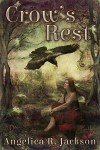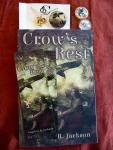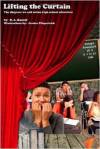Pru Marlowe is an animal psychic and behaviorist—she also happens to be an amateur sleuth! Together with her furred and feathered friends, Pru investigates the crimes in her sleep Berkshire town. This time the victim is a prominent lawyer, and the only witness is a small, white kitten.
Kittens Can Kill is the fifth book in Clea Simon’s Pet Noir series, but don’t let that stop you from jumping in—each book is enjoyable on its own! In this one, Pru is hired to help a kitten adjust to his new home. Upon arrival she finds the kitten…and a dead body! When little Ernesto becomes the prime suspect, Pru races to solve the puzzle before the kitten is put down.
Now, you might be thinking that an amateur sleuth who talks to animals might make for a slightly unbelievable story, but not in Simon’s hands. She has successfully blended the basic non-verbal communications that all animal workers read with the emotional-hit impressions physics try to process.
Although I haven’t read the earlier books, it is clear that Pru has not had it easy. She has a bit of an edge to her, like someone who’s been through too much. Between her “gift,” and (what might be) a painful past, she’s very self-protective. Personally, I find the character “flaws” make her more a more believable character.
And speaking of characters, this book is full of them–spoiled rich girls, crooked business people, busybodies, and a lovably aloof-yet-motherly feline, just to name a few. I had a pretty good idea of “whodunit” before the end of the book, but I still enjoyed the chase.
Please enjoy the following excerpt from Kittens Can Kill, and don’t forget to enter the giveaway!
Synopsis:
 The dead don’t keep pets. So when animal behaviorist expert Pru Marlowe gets a call about a kitten, she doesn’t expect to find the cuddly creature playing beside the cooling body of prominent Beauville lawyer David Canaday. Heart attack? His three adult daughters angrily blame drug interactions, feline allergies—and each other. And begin to feud over their father, his considerable estate, and that cute ball of fluff. While the cause of death is pending, each sister has an axe to grind—with arguments that escalate when David’s partner reads out the will.
The dead don’t keep pets. So when animal behaviorist expert Pru Marlowe gets a call about a kitten, she doesn’t expect to find the cuddly creature playing beside the cooling body of prominent Beauville lawyer David Canaday. Heart attack? His three adult daughters angrily blame drug interactions, feline allergies—and each other. And begin to feud over their father, his considerable estate, and that cute ball of fluff. While the cause of death is pending, each sister has an axe to grind—with arguments that escalate when David’s partner reads out the will.
Pru’s special sensitivity to animals, which caused her to flee the cacophony of Manhattan for the quiet Berkshires, adds further problems. The local vet is overwhelmed as the animal hospital’s money runs out. There’s a needy Sheltie and some invasive squirrels, too. But the dead man’s kitten, his former partner, and his troublesome family keep drawing “wild-girl animal psychic Pru back in. Despite the wry observations of her trusty tabby Wallis, now the wrongfully accused kitten’s guardian, and the grudging compliance of her cop lover, this may be one time when Pru can’t solve the mystery or save the kitten she wants to believe is innocent. A single witness knows the truth about that bright spring morning. How far can Pru investigate without risking her own hidden tale?
Book Details:
Genre: Cozy Mystery
Published by: Poisoned Pen Press
Publication Date: 03/03/2015
Number of Pages: 434
Series: Pru Marlowe Pet Noir #5 (Each is a Stand Alone Mystery)
ISBN: 9781464203589
Read an excerpt:
Chapter One
There’s nothing cute about a death scene. Not the shards of the mug that rested in a puddle on the cold tile floor. Not the scent of the tea—acrid and sharp—that now mingled with the mustier odors of a body’s last struggle. And certainly not the body itself, sprawled contorted beside the shattered ceramic, one arm reaching out for succor, the other frozen in rigor as it clawed at the argyle wool vest that covered the still chest.
No, there was nothing cute about the tableau that greeted me when I made my way into the kitchen of Mr. David Canaday, Esquire, after twenty minutes of pointless knocking. But the kitten that sat beside the puddle, batting at a metal button that must have popped off the vest in that last desperate effort? That little white puffball, not more than eight weeks old and intent as he could be on his newfound toy as it rolled back and forth? He was adorable. The cutest little bundle a girl could ever swoon for.
He knew it, too. As I stood there, staring, he batted that button toward me. Rolling around on its rounded top, it made its slow circular way toward my feet.
“Play?” The message in those round blue eyes was clear. I was supposed to kick the button back. To get it moving—make it livelier prey than the still man on the floor would ever be again. “Back to me?”
The button hit my boot, and the kitten reared up when I stepped back, his front paws reaching up to slap the air.
“No, kitty. I can’t.” I took another step back the way I had come.
“Play?” And another.
I had no desire to kick the button. What I wanted to do was scoop up this little puffball and run.
To remove such an innocent creature from the horror before me. That had been my plan, even before I’d walked into the room. Get the kitten, get out. Get on with my day.
That didn’t look like it was going to happen. Not now, and as much as I wanted to snatch the kitten up I restrained myself and, fiddling with my bag, found my phone while I took a third step and a fourth back to the kitchen door. As much as I wanted to grab up the kitten and run for dear life, I knew better than to disturb what just might be a crime scene—or to remove what I assumed to be the only living witness.
Chapter Two
The paramedics arrived first, and for that I was grateful. They had the body on a stretcher by the time the daughter arrived, straps across those jolly blue diamonds and a blanket covering the soiled khakis below. Better still, they were the ones to tell her what that still, pale face should have. What had been patently obvious to me from the moment I’d stepped into the room: Dad was dead. They were taking him to the hospital—that was protocol—but there’d be no sirens wailing because there was no great rush. Lucky for me, she opted to ride along.
I didn’t envy the paramedics. The daughter looked like the type who would fight them. Insist on CPR or defibrillation, even as the old man’s color faded to a muted version of that vest, the blood slowly settling in his back.
She didn’t look much better. Pale as dishwater, with hair to match. That hair, a listless bob, had been dark once, maybe as black as mine, but time had dulled its color and its sheen, much as it had softened what might have once been impressive cheekbones and a jawline that now sloped gently into a chubby neck.
Between that pallor and the way she had carried on, I had thought at first that she was the wife. Then I remembered: the old man was widowed. It was his daughter who had called me, asking for help in settling a new pet with an increasingly shut-in and by all accounts difficult elder.
“It needs everything,” she had said when she’d called. “Shots, whatever.”
I’d been bothered by that impersonal “it.” Sexing a kitten can be difficult, but this smacked of something colder. Still, I’d said I’d call Doc Sharpe, our local vet, to set up a well-kitten visit and silently figured on adding taxi and escort charges.
In the meantime, I’d told the daughter that I’d drop by to set things up. As the woman on the phone had gone on, though, I’d begun adding services. Neither she nor her father had expected this kitten. She had errands to run, she’d said, and sounded particularly put out by its sudden, unannounced appearance.
It—that impersonal “it” again—had been an unexpected gift, the caller had said. And while that sounded odd, I wasn’t going to question it. Not if they were willing to pay.
That gig was shot, I thought as I watched the ambulance from the shelter of an eager rhododendron, blossoms ready to pop.
Sure, I could bill for my time. I’d certainly charge for the load of supplies in my car. But I wouldn’t count on getting paid, not soon anyway. Spring and my business usually picked up. The tourists started filtering back, and the seasonal condos filled with troubled dogs and angry cats, all confused by the very human idea of relocating for fun. But even though the May days were growing soft, my client base hadn’t warmed up yet. I’d been counting on this job for at least a few regular checks.
“Mama? Where did you go?” The soft cry brought me out of my musing. Male, definitely, though still much more a baby than a boy. Spring. I looked through the bush’s dark green leaves for a nest. For a den in the dark, damp leaves beneath the trees.
“Where are you?”
The kitten. Of course. With all the hubbub, the tiny animal must have been spooked. Must have darted for safety and gotten outside. I couldn’t recall anyone mentioning the little cat as they strapped the old man to the gurney and bundled his daughter in for the ride.
“Play?”
The kitten was determined, I’d give him that. And he seemed to have gotten over his fright. I looked around. The EMTs had left the door ajar when they first stormed in, and the little fellow probably snuck out. Normally, I’d cheer him on. Self-determination is a virtue that I applaud, but a baby is a baby, after all.
And while the east side of Beauville might look nicer than our shabby downtown, part of the appeal was its old-growth woods.
I thought of the foxes that would be nesting soon beneath those trees. And the fishers, and a few other predators, all of whom would be looking for a tasty morsel for themselves or their own young. Nature, right? With a sigh that probably revealed more about my human nature than I’d care to admit, I dropped to my knees. Besides, it wasn’t like I was doing anyone else any good just then.
“I’m here, little fellow,” I called out softly, peering around the shrubbery. “Where are you?”
He didn’t answer, not that I really expected him to. I should explain that this is odd for me. I have a sensitivity, you see.
Some people might call it a gift. I can pick up what animals are thinking, hear their thoughts like voices in my head. Yes, I know how nutty that sounds. That’s why I keep my particular sensitivity to myself, although I have a feeling that others are growing suspicious.
But the thing about picking up animals’ voices is that they don’t talk like you or I do. They have no need for meaningless conversation, and they certainly don’t chatter just to hear themselves speak. And so although I tend to perceive their voices in human terms—that kitten asking for its mother, for example—that’s just my weak human brain trying to make sense of what I’m really getting. Which was a young animal coming to terms
with its environment. That kitten wanted to play, because playing is its job—how it learns to hunt, to survive. He had appeared to address me because kittens, like all mammals, learn from their mothers, their peers. From the world around them. He wasn’t calling to me, specifically. He was reaching out, because he was alone.
Alone. That was part of what I was getting, but there was something else, too—an undercurrent of loneliness and confusion, a jumble of noise and fear and…
“Back to me? Kick it again?”
Boredom? Well, as I’ve said, play is a young animal’s job.
And while I didn’t necessarily want to play kick the button, I was grateful for the repeated plea. The voice was clearly coming from inside.
I turned back to the silent house. Although I’d walked in with no problem—Beauville still being that kind of place—someone had thought to lock the door. Luckily, the latch was a simple one, and it gave way quickly to the thin blade of the knife I always keep close at hand. This wasn’t breaking-and-entering. Not really, I told myself as I closed the door carefully behind me. I’d been hired to take care of a kitten, and that’s what I was going to do.
“Kitten? Hello?” As I’ve said, I wasn’t really expecting an answer. What I was doing was announcing my presence, trying to sound as nonthreatening as I could, which for me meant voicing my thought in the form of a question.
“Back to me!” I tried to echo the thought I had picked up. The kitchen remained still and apparently empty. I proceeded through the open archway into what appeared to be a living room. “You there?”
“Play with me!” That insistent voice. “Why won’t he play with me?”
I didn’t have the heart to tell him, but I had to. “He’s gone,” I said.
“Gone?” The question bounced back, like that button. The small creature was trying to make sense of my response. Of the word. I kicked myself. I wasn’t doing the kitten any favors with my euphemism. Animals live or die in the physical world, and despite this one’s infant appeal, he probably had a better sense of reality than most of the humans in this town.
“Dead,” I said, summoning the memory of the still, cold body.
“Gone?” The damage had been done, and I felt the confusion as the kitten continued to roll that word—that concept—about in his tiny feline brain.
“Catch me!” The button appeared, rolling in a slow semicircle from under a chair. “Let’s play!”
“Kitten?” I ducked down and leaned beneath the coffee table.
There, eyes wide, crouched the little creature. He’d taken refuge from all the commotion. Up close, I could see he was undersized and a little ragged, more ready to pounce than to groom. I reached for him and he reared up, batting at me with cool paw pads. “Okay, little fellow.” I scooped him up, and as he nuzzled against my shirt, I felt a wet spot on his back.
“Feels like you’ve been trying to wash.” No wonder his fur looked patchy. “Or did you get splashed?”
***
I sniffed the kitten and caught something funky. Tea, I hoped, and not something more gruesome. I didn’t think I was imagining a slight mint scent, and any puddles on the floor where the body had fallen had been trampled into dark stains. Mimicking my action, the kitten stretched around to sniff the wet spot, and promptly sneezed.
“Gesundheit, little fellow.” He looked up at me, eyes wide, and sneezed again. An adorable little snort, prompted perhaps by that touch of mint. But I’ve been in this business too long not to think of the other possibilities: feline viral rhinoneumonitis—FVR, better known as feline herpes—for example. Not fatal, but something to manage. At any rate, I held the little creature under the tap for a moment. He was young enough
to take my impromptu bath without too much fuss and was purring as I rubbed him down with a dish towel.
“Excuse me.” The voice behind me made me twirl around and the kitten jumped to the floor. He landed by a pair of cowboy boots—turquoise blue—attached to jeans that fit like a second skin. On top of these, a woman’s face scowled at me, the eyes wide and regal. “But who are you, and what are you doing in my father’s house? And what are you doing with my kitten?”
Author Bio:
 A recovering journalist, Clea Simon is the author of 17
A recovering journalist, Clea Simon is the author of 17
mysteries and three nonfiction books. Parrots Prove Deadly is the third in her Pru Marlowe pet noir series. She lives in Somerville, Massachusetts, with her husband Jon and their cat, Musetta, and can be reached at
Click Here to Follow the Blog Tour
Giveaway:
This is a giveaway hosted by Partners In Crime Virtual Book Tours for Clea Simon & Poisoned Pen Press. There will be one winner of 1 Box of Poisoned Pen Press books including Kittens Can Kill by Clea Simon. The giveaway begins on June 1st, 2015 and runs through June 3rd, 2015.


















